In Jane Jacobs’ footsteps, exploring what’s ‘urban’
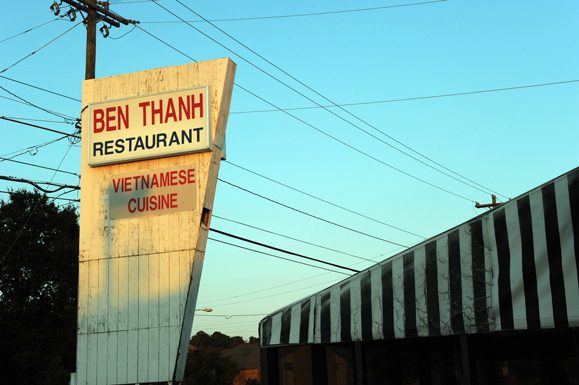
Tom Hanchett and I have been having this discussion – some might call it a debate – over what’s the most “urban” part of Charlotte.
Hanchett, staff historian at Levine Museum of the New South, contends that the most urban corner in the city is Central Avenue at Rosehaven Drive. For weeks I have respectfully declined to agree, because by virtually any standard of city form or urban design, nothing at that corner is urban. For that matter, by most standards of city form and urban design, not much in this whole Sun Belt boomtown of 730,000 is what you’d call “urban.”
View Would Jane Jacobs think THIS is ‘urban’? in a larger map
But on Saturday, May 5, as Hanchett and I and 20 other Charlotteans on a “munching tour” though a handful of stores and restaurants within a stone’s throw of said corner, his thesis began to sink in. Am I convinced? Read on.
Hanchett, who is not only a Ph.D. historian but a remarkable chowhound, had agreed to lead Charlotte’s first Jane Jacobs Walk. It was one of dozens of similar community walks in 31 U.S. cities held to mark the May 4, 1916, birth of Jane Jacobs, an urban writer and thinker who by the 1960s was upending conventional thinking about U.S. cities. The walk was sponsored by PlanCharlotte.org, the newest website project at the UNC Charlotte Urban Institute, and the Levine museum.
Our idea was to see how Jacobs’ thinking about cities applies in that small slice of Charlotte. 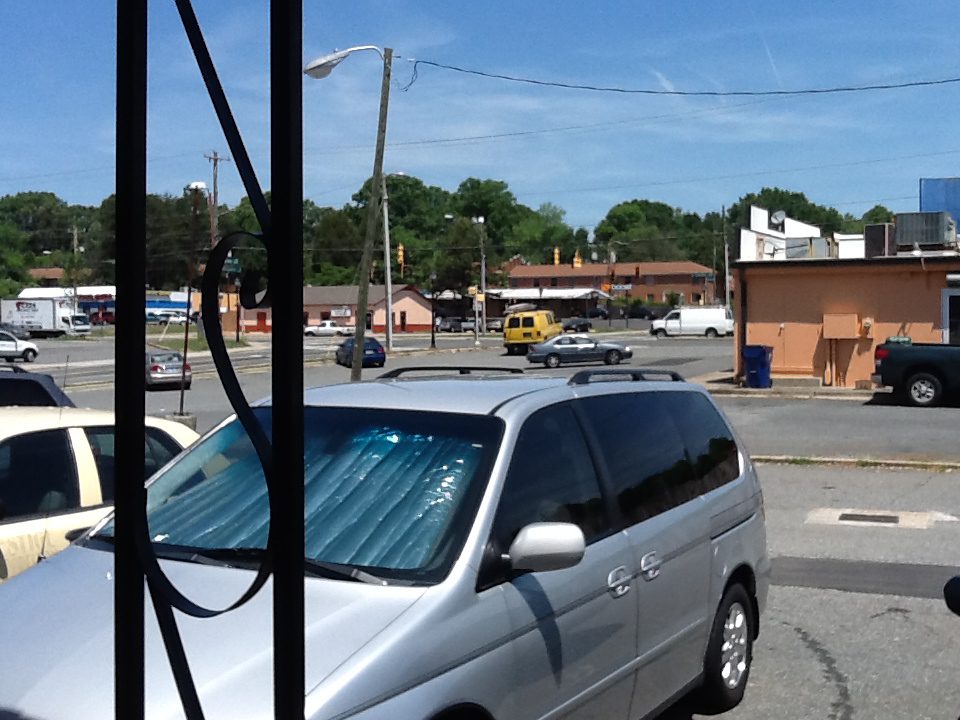 “Walk, observe, connect,” is the slogan for Jane Jacobs Walk, the national organizing group. Hanchett was convinced Jacobs, if she could have accompanied us, would have instantly seen “urban” in what we were walking through.
“Walk, observe, connect,” is the slogan for Jane Jacobs Walk, the national organizing group. Hanchett was convinced Jacobs, if she could have accompanied us, would have instantly seen “urban” in what we were walking through.
Maybe I hang out with too many urban designers and planners, though. Because I always look around that area and see tattered strip shopping centers and aging restaurant buildings surrounded by asphalt parking lots. After all, Jacobs wrote about how important it is for a city to have lots of different things close together. She described the instrumental role city sidewalks play, not just as places to walk but as social connecting points where an all-but-invisible network of merchants, neighbors, street vendors, kids, teens and grownups all act together, if unconsciously. She called it a sidewalk ballet, but it’s also a pattern that lubricates commerce, teaches community values and builds public safety.
Our tour met up at Ben Thanh on Central Avenue, one of the city’s best Vietnamese restaurants, although from the outside it would be hard to tell that. It’s the most recent in a string of restaurants to occupy a building that looks to have begun life as some sort of second-tier franchise restaurant. The asphalt parking lot is potholed and cracked. Inside, the décor can’t disguise the building’s age; tax records show it was built in 1977. Hanchett himself has called the area a “landscape of unremarkable suburban sprawl.”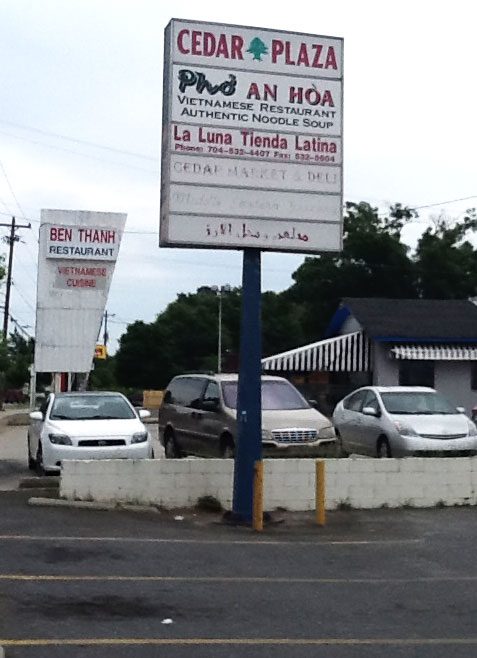
This is a part of Charlotte, built mostly in the 1950s through ’70s, where urban designers would not even take time to push their stylish spectacles up their noses before starting to sketch designs for suburban retrofits. They’d propose adding new buildings close to the street with stores on the ground floor, housing above. They’d build parking decks, so surface lots could hold new buildings. They’d try to organize the haphazard jumble of dilapidated strip centers into city-style sidewalks with city-style storefront shops and restaurants.
Our tour didn’t do those things. Instead, we ate fresh summer rolls, introduced ourselves, and talked a bit about Jacobs’ writings. Hanchett read aloud one of my favorite passages:
“Cities need old buildings so badly it is probably impossible for vigorous streets and districts to grow without them. By old buildings I mean not museum-piece old buildings, not old buildings in an excellent and expensive state of rehabilitation – although these make fine ingredients – but also a good lot of plain, ordinary, low-value old buildings, including some rundown old buildings.”
Enterprises that can afford to locate in new buildings, Jacobs wrote, must either be high-profit or heavily subsidized. “New ideas [meaning start-up businesses or other innovations just getting off the ground] must use old buildings.”
Our next stop was next door, Cedar Plaza, a concrete-block shopping strip built in 1988. Hanchett pointed out the Vietnamese restaurant at one end, Lebanese grocery and restaurant, Cedarland, at the other, and in between a Latino grocery. He pointed to a jumbled bulletin board between the restaurant and the tienda, which holds notices and posters in Spanish, Vietnamese and English. It’s something of a community center, he pointed out.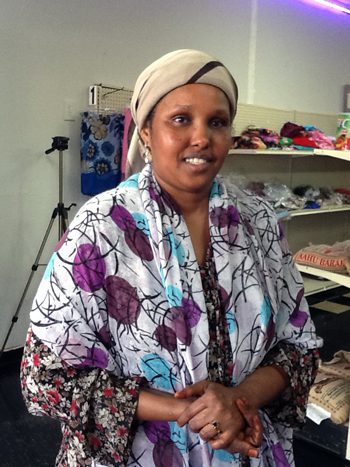
The group split up to explore the Latino and Lebanese stores. I went into Cedarland in search of Aleppo pepper and emerged, one baklava piece heavier, with No. 1 bulgur with which to make tabbouleh.
Time for lunch. We poured into Jamile’s International Cuisine, about 300 feet away, and I recognized the building (built in 1974) as having housed, 30 years back, La Strada, a pizza restaurant that served delicious deep-dish pizza. Now it holds an Ethiopian restaurant and night club as well as Jamile’s, the start-up business of Somali refugees Jamile Shiekh, her husband, Sadak Dini, and her partner Hamsa Hashi.
Hanchett ordered for us – a tasty stew called chicken suqar, often spelled suqaar. (Perhaps thinking the group too squeamish, Hanchett had chosen not to order the goat meat option.) The food arrived with Jamile’s freshly cooked canjeera (a flatbread), jalapeno dipping sauce and the customary banana which, we learned, accompanies most Somali meals.
Then we waddled back toward our starting point, for tres leches cake or flan (caramel custard) at El Pulgarcito. Owned by Honduran Henry Chirinos, whose wife is Salvadoran, the restaurant offers dishes from both countries as well as Mexico.
What would Jane Jacobs say about all this? First, I imagine she would have loved the food exploration, as we all did. Would she find the tattered suburban-style buildings too much to stomach? Or would she, like Hanchett, see a small but important piece of a city economy?
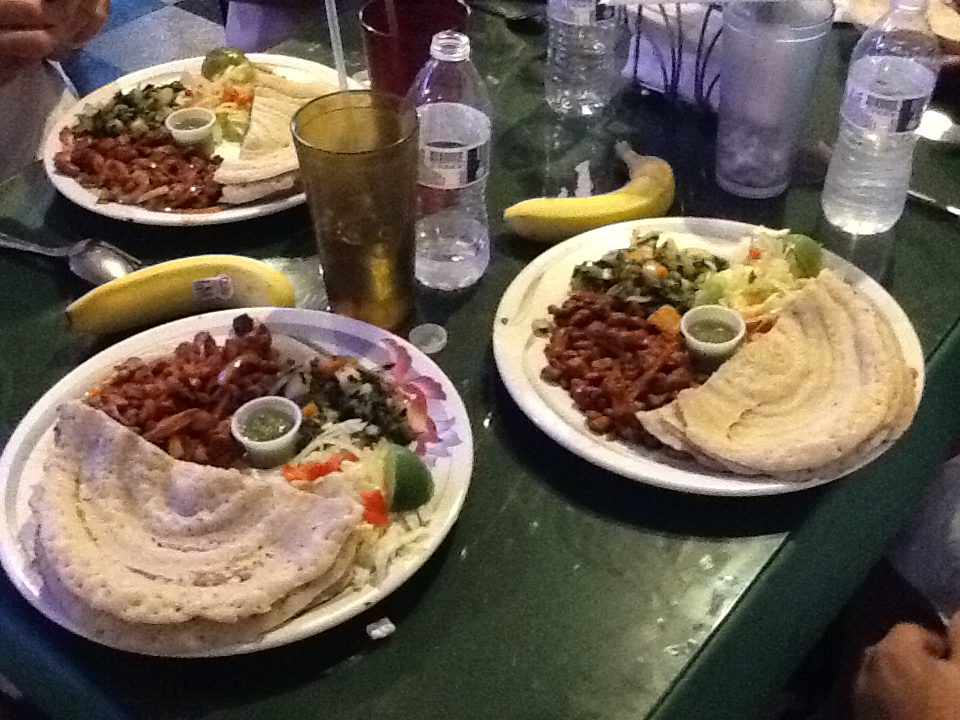 Many people have read Jacobs’ 1961 book, The Death and Life of Great American Cities. Not as many read her 1969 book, The Economy of Cities. In that book, she dissects how city economies grow, how new work builds on existing work, new innovation builds on older innovation, all of it because the innovators, creators and newborn businesses are close enough to learn from each other and do business together. That closeness is one of a city’s most valuable qualities.
Many people have read Jacobs’ 1961 book, The Death and Life of Great American Cities. Not as many read her 1969 book, The Economy of Cities. In that book, she dissects how city economies grow, how new work builds on existing work, new innovation builds on older innovation, all of it because the innovators, creators and newborn businesses are close enough to learn from each other and do business together. That closeness is one of a city’s most valuable qualities.
Cities, as Hanchett pointed out, welcome newcomers and allow them to start businesses. That is precisely what’s happening near Central and Rosehaven. It isn’t Greenwich Village in Manhattan, but for Charlotte it’s comparatively dense with apartment and condo complexes as well as single-family subdivisions. It has sidewalks along busy Central Avenue, and it has foot traffic.
And it has entrepreneurial energy. For better or worse, none of the three restaurants we visited were launched with any Small Business Administration loans or any official bank financing. Cuong Duont, of Ben Thanh, told me the business used family money. Jamile’s husband, Sadak Dini, said they used their own money, saved over 16 years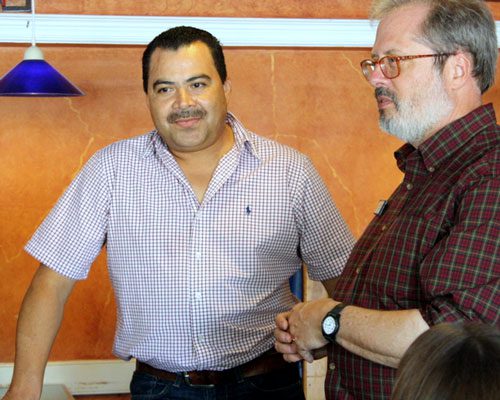 of working in a Charlotte factory. Chirinos also said he used his own money to launch El Pulgarcito, in a building dating to 1966, after nine years at a Long Island country club.
of working in a Charlotte factory. Chirinos also said he used his own money to launch El Pulgarcito, in a building dating to 1966, after nine years at a Long Island country club.
This is the ground floor of a city economy. No subsidies, no meetings with bankers. Newcomers see what products the market might need and start to offer them. Here is where the city is absorbing newcomers, creating businesses and blending different cultures into a tasty suqaar for anyone who might want it.
“It took me a long time to see the resilience of these neighborhoods,” Hanchett told me the day before he led the tour. “It’s important to look at and cherish these landscapes that don’t get much respect.”
In the end, we walked, we observed and we connected. Jane Jacobs, I concluded, would have understood.
Views expressed in this commentary are those of the author and do not necessarily represent the views of the UNC Charlotte Urban Institute, its staff or the University of North Carolina at Charlotte.
Other articles about Charlotte’s Jane Jacobs Walk:
Creative Loafing Charlotte’s “Eat my Charlotte” food blog by Kelly Davis.
WFAE’s food blog, wfaeats.org, by Tanner Latham and Lisa Miller.